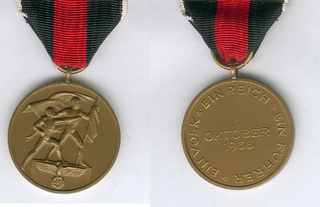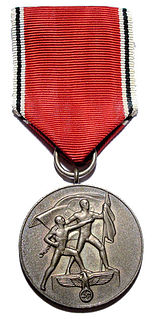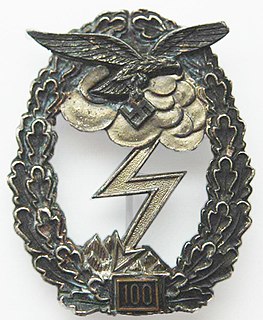Awards and Decorations of Nazi Germany were military, political and civilian decorations that were bestowed between 1923 and 1945, first by the Nazi Party and later the state of Nazi Germany.

The Narvik Shield was a World War II German military decoration awarded to all German forces that took part in the battles of Narvik between 9 April and 8 June 1940. It was instituted on 19 August 1940 by Adolf Hitler. The Oberkommando der Wehrmacht (OKW) published the order the same day. It was bestowed by General Eduard Dietl, the commander of Army Group Narvik.

The Wound Badge was a German military decoration first promulgated by Wilhelm II, German Emperor on 3 March 1918, which was first awarded to soldiers of the German Army who were wounded during World War I. Between the world wars, it was awarded to members of the German armed forces who fought on the Nationalist side of the Spanish Civil War, 1938–39, and received combat related wounds. It was awarded to members in the Reichswehr, the Wehrmacht, SS and the auxiliary service organizations during World War II. After March 1943, due to the increasing number of Allied bombings, it was also awarded to civilians wounded in air raids. It was awarded when the wound was the result of enemy hostile action. In 1957, the West German government authorized a denazified version of the basic badges for wear on the Bundeswehr uniform, among other certain Nazi-era wartime awards.

The Spanish Cross was an award of Nazi Germany given to German troops who participated in the Spanish Civil War, fighting for nationalist general, later Spanish caudillo, Francisco Franco.

The 1 October 1938 Commemorative Medal, commonly known as the Sudetenland Medal was a decoration of Nazi Germany awarded during the interwar period, and the second in a series of Occupation Medals.

The Close Combat Clasp was a World War II German military award instituted on 25 November 1942 for participation in hand-to-hand fighting at close quarters. Intended primarily for infantry, other Wehrmacht, Waffen-SS, ground Luftwaffe units and paratroopers were also eligible.

The Anschluss Commemorative Medal was a decoration of Nazi Germany awarded during the interwar period, and the first in a series of Occupation Medals.

The Return of Memel Commemorative Medal was a decoration of Nazi Germany awarded during the interwar period, the last in a series of Occupation Medals.
The Danzig Cross was a Nazi decoration of the Free City of Danzig. The Cross was instituted on 31 August 1939 as a two grade decoration by Danzig Gauleiter Albert Forster. It was awarded to those, both in Danzig and in the wider Reich, who contributed to building up the Nazi Party in the Free City prior to its incorporation into Germany on 1 September 1939.
The German Occupation Medals were a series of awards, also known as the "Flower War medals", created to commemorate the successive annexations by Nazi Germany of neighbouring countries and regions with large ethnic German populations. These comprised Austria, the Sudetenland and Memel. The occupation of the remainder of western Czechoslovakia was marked by the 'Prague Bar', worn on the ribbon of the Sudetenland Medal.

The Clasp to the Iron Cross was a white metal medal clasp displayed on the uniforms of German Wehrmacht personnel who had been awarded the Iron Cross in World War I, and who again qualified for the decoration in World War II.

The Awards and decorations of the German Armed Forces are decorations awarded by the German Bundeswehr, the German government, and other organizations to the German military and allied forces. Modern era German military awards have been presented since the establishment of the Federal Republic of Germany in 1949.

The Wehrmacht Long Service Award was a military service decoration of Nazi Germany issued for satisfactory completion of a number of years in military service.

The Ground Assault Badge of the Luftwaffe was a World War II German military decoration awarded to Luftwaffe personnel for achievement in ground combat. It was instituted on 31 March 1942 by the commander-in-chief Hermann Göring.

The Lapland Shield was a World War II German military decoration awarded to military personnel of General Franz Böhme’s 20th Mountain Army which fought a two-front campaign against advancing Finnish and Soviet Red Army forces in Lapland between November 1944 and the war’s end in May 1945. It was awarded to men who had "honorably served" for six months in the region or had been wounded during operations there. It was authorized in February 1945 and was the last officially instituted German campaign shield of the war.

The Crete Cuff Title, or Crete Cuff Band, was a World War II German military decoration awarded to Wehrmacht servicemen who took part in the battle of Crete between 20 and 27 May 1941.

The Africa Cuff Title, or Africa Cuff Band, was a World War II German military decoration awarded to members of the Wehrmacht who took part in the North African campaign of 1941–43.
The Metz 1944 Cuff Title, or Metz 1944 Cuff Band, was a World War II German military decoration instituted to reward members of the Wehrmacht who took part in the 1944 battle of Metz.

The Courland Cuff Title, or Courland Cuff Band, was a World War II German military decoration awarded to Wehrmacht servicemen of Army Group Courland who served in the Courland Pocket.

The Warsaw Shield,, or Warsaw Arm Shield, was a planned World War II German military decoration intended for award to Wehrmacht and Waffen-SS servicemen who took part in the suppression of the 1944 Warsaw uprising. Although authorised, with the conditions of award and the design approved and announced, production had not begun prior to the end of the war and the award was never issued.


















